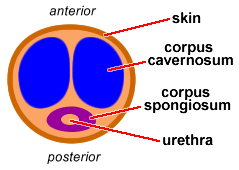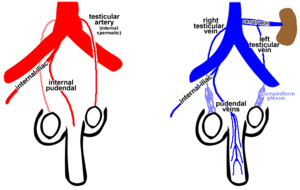Penis
Rather well designed, because it means that in men the urethra is 15cm long, making them less well disposed towards contracting those pesky UTIs. Separated into two parts in textbooks, you have the superficial deep perineal pouches
- The superficial contains the bulb of the penis and the bulbospongiuosus muscle.
- The deep (also called the urogenital diaphragm) contains the membranous portion of the urethra, the bulbourethral gland, and the inferior fascia, the sphincter urethra and the superior fascia.
The base of the penis is found in the superficial perineal pouch, including the %color=#0000ff %bulbospongiosus muscles%%, which contract to empty the urethra and semen, and also compress the deep dorsal vein of the penis, stopping venous drainage and filling the %color=#ff0000 %corpus cavernosum %%('caves' inside the shaft that fill with blood), causing erection.
The end bit, or the glans (the bulby bit) is in the deep perineal pouch. Also of note is the corpus spongiosum, which contains the urethra. This passes through both parts of the penis.
Clinical Conditions
Genital Warts
Caused by human papillomavirus. An STD. The warts appear on the glans, prepuce and the terminal urethra. Highly infectious, and easy to recognise.
Genital Herpes
An STD, caused by herpes simplex 2 (usually). Vesicles appear around the genitalia, generally near the tip of the penis. They burst to leave painful ulcers.
'Syphilis
An STD. First a warty purple lump usually forms on the penis after 2-5 days, followed by an ulcer formation, with enlarged lymph nodes inguinally. It will heal leaving a scar after a few weeks, but will progress over the next two years to become a systemic disease, that can cause madness. However, it is fairly easy to treat, and thus pretty rare in the West.\\
Phimosis and paraphimosis
This is the most common clinical cause for circumcision. Happens when the prepuce – fold of skin over the glans – either can't pass over the glans (phimosis), or can't return once extended (paraphimosis).\\
Urethritis
At the tip of the penis (the glans) the urethra can be subject to chronic inflammation or infection. In the case of gonnococcal infection, there is an acute inflammation of the urethra, followed by a smelly discharge and dysuria. It can lead to strictures in the urethra, causing obstruction, cystitis, pain, poor stream, etc.\\ Non specific urethritis is the commonest STD – commonly linked to Chlamydia.\\

